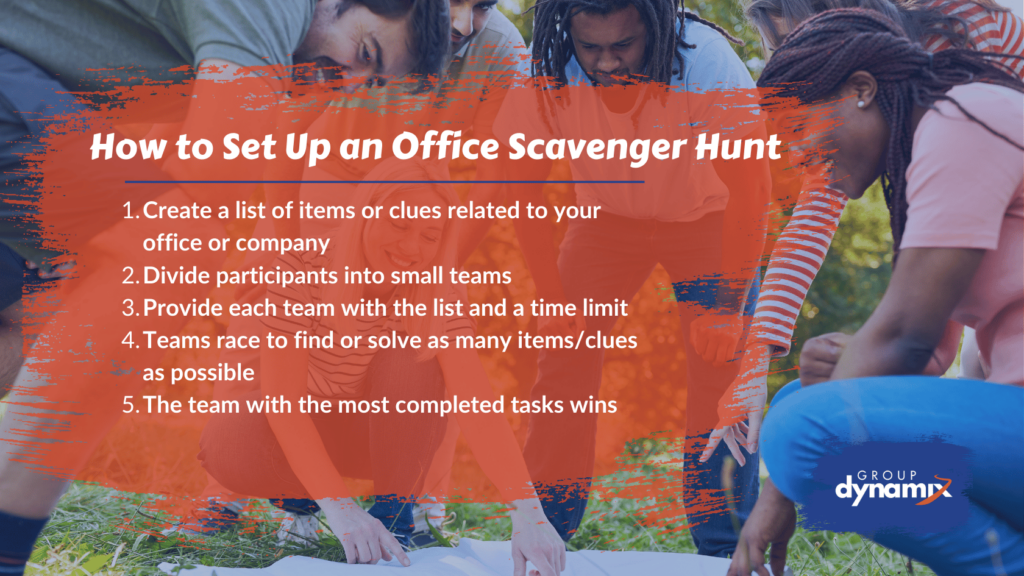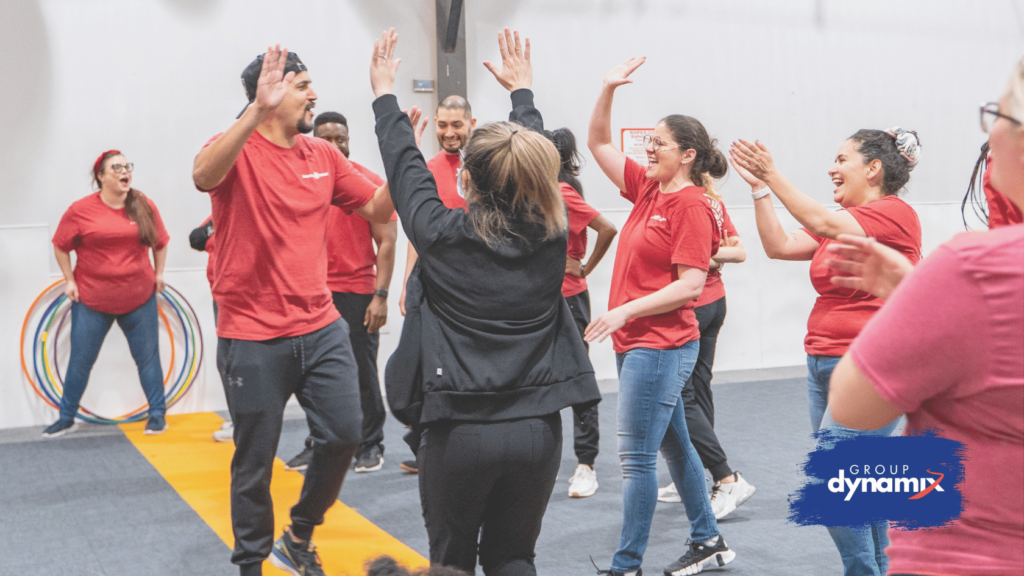Indoor team-building games offer a unique opportunity to break down barriers, boost morale, and enhance communication among team members. These activities aren’t just about fun and games – they’re strategic tools for building a more cohesive and productive workforce.
Whether you’re working with a small group of five or a large team of fifty, there’s an indoor team-building activity that can suit your needs. These games can be adapted for various group sizes, making them versatile tools for any organization. From ice-breakers that help new team members feel welcome to complex problem-solving exercises that challenge even the most seasoned professionals, the world of indoor team building is rich with possibilities.
In this article, we’ll explore four creative indoor team-building games that require minimal materials but deliver maximum impact. These activities are designed to enhance collaboration, foster creativity, and strengthen the bonds between team members. So, get ready to transform your workplace dynamics and unlock your team’s full potential with these engaging and productive indoor team-building games.
As we consider the advantages of indoor team-building activities, especially here in hot Texas, it’s clear that climate-controlled environments provide the perfect backdrop for strengthening team dynamics. Since 1998, Group Dynamix has led the way in innovation, bringing outdoor adventure indoors and transforming the way teams connect and collaborate. This evolution in approach allows teams to engage in meaningful activities year-round, fostering bonds that enhance communication and collaboration.

1. Human Bingo
Human Bingo is an engaging indoor team-building activity that combines fun and interaction, making it a great icebreaker for large corporate groups. Each participant receives a bingo card with prompts about personal experiences or skills, such as “Has visited more than 10 countries” or “Can speak three languages.” The objective is to mingle and find colleagues who match the descriptions.
What sets Human Bingo apart is its versatility; you can customize prompts to fit your team’s demographics or specific goals, keeping the activity relevant and engaging. As players converse and learn about each other, they foster connections and break down barriers, creating a lively atmosphere.
The simplicity of the game requires minimal materials—just bingo cards and pens—making it easy to organize. To ensure success, keep the prompts diverse, blending work-related and personal questions to enhance enjoyment and help build lasting workplace connections.
2. Minefield Navigation
Minefield Navigation is an exciting indoor team-building game that enhances trust, communication, and problem-solving skills. Ideal for small groups or departmental teams, it involves creating a “minefield” using objects like chairs or boxes. Participants pair up, with one blindfolded (the navigator) and the other providing verbal directions (the guide). The goal is for the navigator to cross the minefield without touching obstacles.
This activity promotes reliance on clear communication and trust, simulating workplace scenarios. For added excitement, you can time each pair and track scores on a leaderboard. The game’s flexibility allows for adjustments in difficulty, making it suitable for all team development stages and encouraging strategic communication.
To maximize the learning potential of this activity, consider these tips:
- Rotate roles so that each team member experiences being both the guide and the navigator
- Encourage teams to discuss their strategies before and after each attempt
- After the activity, facilitate a debrief session where teams can share their experiences and insights
Minefield Navigation is more than just a game; it’s a powerful tool for developing crucial workplace skills. By participating in this activity, team members learn to trust each other, communicate more effectively, and work together towards a common goal – all essential elements for success in any professional environment. Be mindful that some individuals may feel uncomfortable with being blindfolded. It’s important not to force anyone to do something they are uncomfortable with, as this could backfire and damage their trust.

3. Group Story Build
Group Story Build is a creative and engaging indoor game that promotes imagination, collaboration, and quick thinking. In this activity, participants sit in a circle and take turns contributing one word to construct a cohesive story. The challenge is to maintain a logical flow while adapting to unexpected twists. Its simplicity and inclusivity make it perfect for impromptu team bonding sessions or as a warm-up before more complex activities.
To add an extra layer of excitement to this group team-building game, consider these variations:
- Theme-based stories: Choose a specific theme or genre, such as “space adventure” or “mystery.”
- Timed rounds: Set a timer and see how far the story progresses within a set time limit.
- Story continuation: Pause the story at a cliffhanger moment and have teams write their own endings.
Group Story Build effectively breaks down communication barriers and encourages participation from all team members, fostering a sense of ownership and inclusion. This activity serves as a metaphor for workplace collaboration, where each person’s contributions build upon one another to create successful projects.
To maximize the benefits of Group Story Build, consider these tips:
- Encourage participants to think quickly and go with their first instinct
- Remind the group to listen carefully to maintain story coherence
- After the activity, discuss how the story-building process mirrors real-world teamwork scenarios
By incorporating Group Story Build into your repertoire of team bonding games, you’re not just providing a fun diversion – you’re cultivating essential skills like adaptability, active listening, and collaborative creativity. These skills are invaluable in today’s dynamic work environments, making this simple yet powerful activity a must-try for any team looking to enhance their collective capabilities and foster a more cohesive group dynamic.
4. Team Charades with a Twist
Team Charades with a Twist is a fun indoor group activity that adds excitement to traditional charades. In this version, teams act out complex concepts, work processes, or company values, making it ideal for corporate team building. This innovative approach transforms a simple game into a valuable tool for reinforcing organizational culture and enhancing team communication.
Here’s how to set up this engaging group team-building game:
- Prepare a list of work-related concepts, processes, or values
- Divide participants into teams of 4-6 people
- One team member acts out the concept while their team tries to guess
- Set a time limit for each round (e.g., 2 minutes)
- Award points for correct guesses and creative performances
What sets Team Charades with a Twist apart from other indoor office games is its ability to combine fun with practical learning. As team members act out and guess work-related concepts, they’re not only bonding but also reinforcing their understanding of important workplace ideas and processes.
To make this activity even more engaging, consider these variations:
- Silent Movie: Actors can only use facial expressions and body language; no sound allowed
- Reverse Charades: The entire team acts out the concept for one guesser
- Progressive Charades: Teams build on each other’s performances, adding new elements each round
This game excels at breaking down barriers between departments and hierarchies. When everyone from interns to executives is equally challenged to act out a “quarterly budget review” or “customer-centric approach,” it creates a level playing field and encourages open communication.
As with all team bonding games, the real value of Team Charades with a Twist lies in the debrief. After the laughter subsides, take time to discuss:
- Which concepts were easiest/hardest to convey?
- How did teams develop their strategies?
- What parallels can be drawn between the game and workplace communication?
By incorporating Team Charades with a Twist into your repertoire of group team-building games, you’re not just providing a fun diversion. You’re creating an opportunity for teams to practice nonverbal communication, think creatively about complex concepts, and build stronger connections with their colleagues. This blend of entertainment and education makes it a standout choice for any organization looking to enhance team dynamics while reinforcing key business concepts.

5. Office Scavenger Hunt
The Office Scavenger Hunt is a thrilling addition to your repertoire of indoor team-building games that combine exploration, problem-solving, and collaboration. This activity stands out among indoor office games for its ability to engage employees while familiarizing them with their work environment in a fun and interactive way.
Companies that prioritize team building report a 25% increase in team performance, and the Office Scavenger Hunt is a perfect example of why. This game encourages teamwork, creative thinking, and friendly competition, all of which contribute to enhanced workplace dynamics.
Here’s how to set up this exciting group team-building game:
- Create a list of items or clues related to your office or company
- Divide participants into small teams
- Provide each team with the list and a time limit
- Teams race to find or solve as many items/clues as possible
- The team with the most completed tasks wins
What makes the Office Scavenger Hunt unique among fun indoor group games is its adaptability. You can tailor the hunt to focus on company history, office layout, or even specific departmental knowledge. This customization ensures that the activity remains relevant and engaging for all participants, regardless of their role or tenure.
To elevate this game from a simple search-and-find activity to a powerful corporate team-building exercise, consider incorporating these elements:
- Puzzle-solving: Include riddles or codes that teams must decipher to find items
- Photo challenges: Require teams to take creative photos with found objects
- Interdepartmental cooperation: Design tasks that require teams to interact with different departments
The Office Scavenger Hunt excels at breaking down silos within an organization. As teams race around the office, they interact with colleagues they might not typically engage with, fostering new connections and improving interdepartmental communication.
Businesses that engage in regular team-building activities have a 36% higher employee retention rate than those that do not. The Office Scavenger Hunt contributes to this by creating shared experiences and memories that strengthen team bonds and increase job satisfaction.
To maximize the benefits of this activity, consider these tips:
- Ensure the hunt includes a mix of easy and challenging tasks to keep all team members engaged
- Incorporate tasks that highlight company values or recent achievements
- Conclude with a debrief session to discuss strategies used and lessons learned
By implementing the Office Scavenger Hunt as part of your corporate team-building games, you’re not just providing a fun diversion. You’re creating an opportunity for employees to explore their workplace, collaborate with colleagues, and gain a deeper understanding of their company culture. This blend of entertainment and education makes it an invaluable tool for any organization looking to boost team performance and employee engagement.

6. Reverse Pictionary
Reverse Pictionary is a creative twist on a classic game that deserves a top spot on any indoor games list. This innovative activity combines the fun of traditional Pictionary with a unique challenge that promotes clear communication and creative problem-solving, making it an excellent choice for corporate team-building games.
Effective team-building initiatives can increase employee engagement by up to 30%, and Reverse Pictionary is designed to do just that. Flipping the script on a familiar game encourages participants to think differently and engage with their colleagues in new ways.
Here’s how Reverse Pictionary works:
- Divide participants into teams of 3-5 people
- One team member (the “artist”) faces away from a whiteboard or large paper
- The rest of the team describes an image or concept to the artist
- The artist must draw based solely on the team’s verbal descriptions
- Teams compete to create the most accurate representation within a time limit
What sets Reverse Pictionary apart from other fun indoor group games is its focus on descriptive communication. Team members must find creative ways to explain visual concepts without using obvious words, fostering precise language skills and out-of-the-box thinking.
To enhance this group team-building game, consider these variations:
- Work-related themes: Use concepts or processes specific to your industry
- Progressive drawing: Rotate artists every minute to build on each other’s work
- Blind collaboration: Have two artists draw simultaneously based on the team’s instructions
Reverse Pictionary excels at breaking down communication barriers and encouraging clear, concise instructions. It’s particularly effective for teams that struggle with conveying complex ideas or for departments that need to improve their interdepartmental communication.
75% of employees who engage in team-building activities report improved communication with their peers. Reverse Pictionary directly contributes to this improvement by challenging participants to articulate their thoughts clearly and listen actively to their teammates.
To maximize the benefits of this team bonding game, consider these tips:
- Encourage teams to develop a strategy before starting
- Mix up team compositions to promote cross-departmental interaction
- Hold a debrief session to discuss communication challenges and successes
By incorporating Reverse Pictionary into your roster of corporate team-building games, you’re not just providing a fun activity. You’re creating an opportunity for employees to hone their communication skills, practice giving and receiving feedback, and work collaboratively towards a common goal. These skills are invaluable in any workplace, making Reverse Pictionary a powerful tool for enhancing team dynamics and fostering a more cohesive work environment.
Remember, the key to success with this game lies in its ability to challenge participants while keeping the atmosphere light and enjoyable. As teams laugh over misinterpreted instructions and celebrate their artistic triumphs, they build stronger bonds and develop skills that will serve them well beyond the game itself.
Conclusion
As we conclude our exploration of creative indoor team-building games, it’s evident that these activities are more than just fun; they enhance collaboration, communication, and team cohesion. Statistics show that employees engaged in team-building are 64% more focused, leading to improved productivity. Additionally, 85% of individuals believe trust is vital for high-performing teams, and these activities foster that trust through shared experiences and collaborative problem-solving.
The benefits of team building extend beyond just improved focus and trust. Team building can lead to a 20% reduction in workplace conflict and a 20% boost in innovation. By engaging in activities like Human Bingo, Minefield Navigation, or Reverse Pictionary, teams learn to communicate more effectively, resolve conflicts constructively, and approach challenges with creativity and innovation.
To maximize the benefits of indoor team-building games, implement them consistently and integrate them into your company culture. These activities foster collaboration, open communication, and strengthened connections among team members.
Ready to elevate your team’s collaboration and communication? Contact us today to explore tailored team-building solutions designed to fit your organization’s unique needs and goals!

